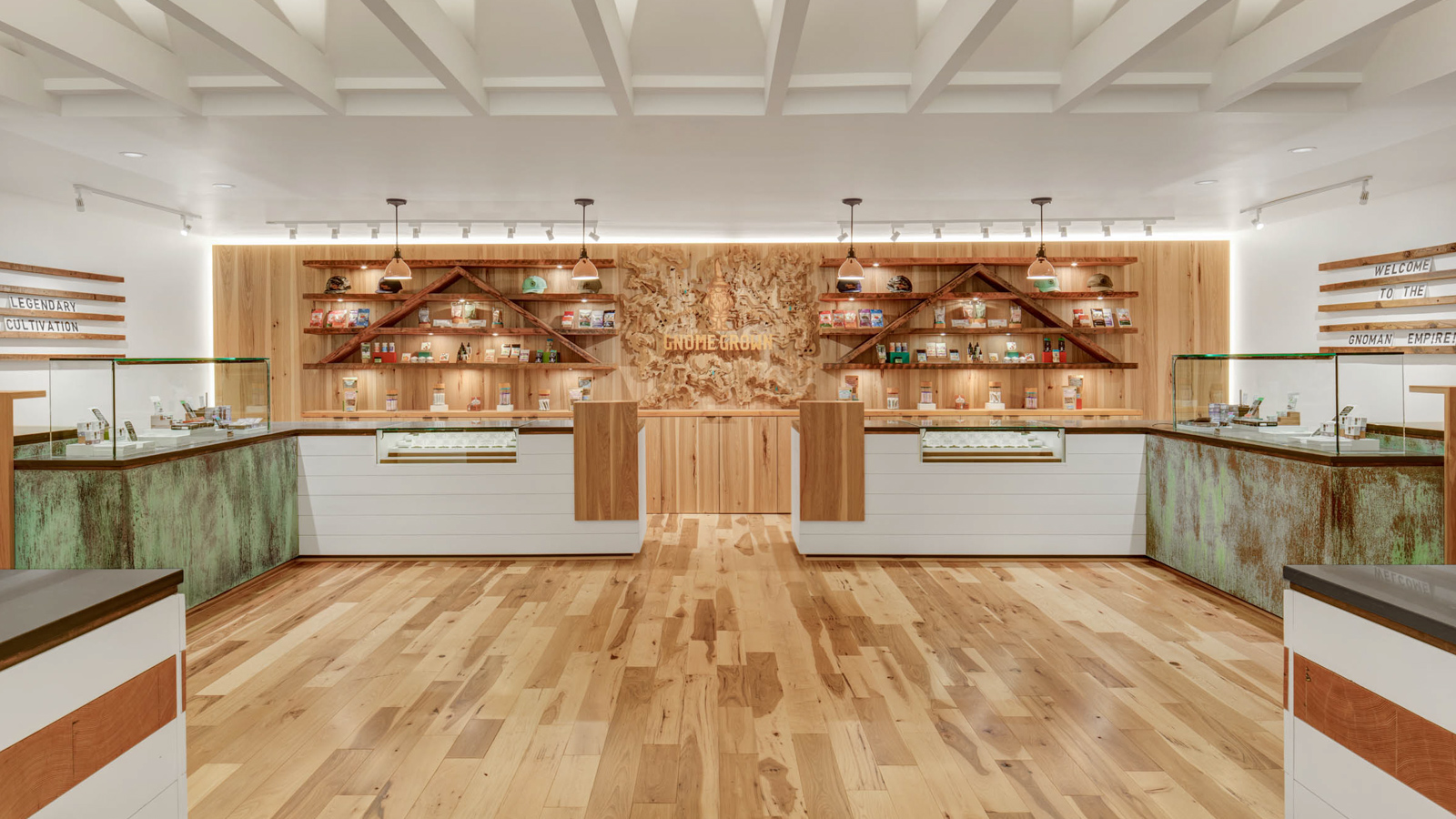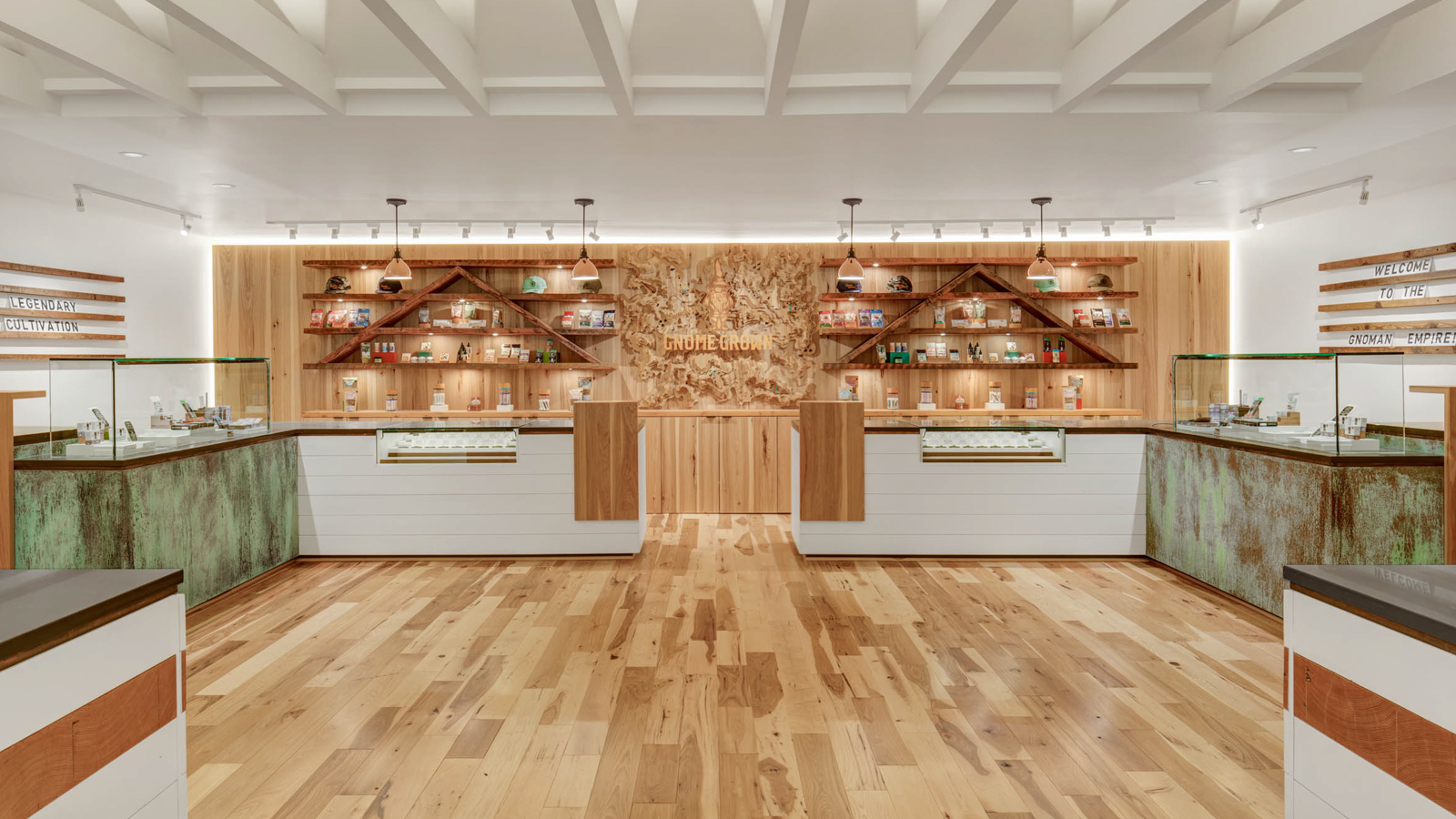
In the early days of cannabis legalization, the rush to open dispensaries was so fast and furious that little thought was given to the retail aesthetics and experience. But today, in an increasingly competitive market, retail design is beginning to take notice as a way to capture the hearts, minds, and Instagram stories of new cannabis consumers.
Just look at this Instagram post of an overzealous customer showing off his dance moves in Planet 13, a high-end dispensary in Las Vegas.
“Five years ago, when I started High Road Design Studio you could hardly find anything on the internet that connected design or retailing with the cannabis space,” said Megan Stone, an interior designer who runs an Arizona-based design firm specializing in cannabis businesses. “It was hard for me to find clients who understood the value of design, because design had just not been witnessed much in this industry before. That’s changed as the industry has grown and expanded.”
Interior retail design involves integrating brand-specific elements of a space — things like the store’s flow, signage, and fixtures — into an overall design with a cohesive brand statement that helps drive sales and provides a positive customer experience, according to Cutler, a Canadian interior design and architectural firm.
That Was Then, This is Now
The trend toward design-heavy retail aims to capture customers new to cannabis and improve the overall customer experience, according to industry experts.
Take improving the checkout experience through design, for example. Ron Throgmartin, the CEO of Seattle-based retail brand and retail development company Diego Pellicer Worldwide, said the company’s designs feature six checkout stations, wide aisles, and a dispensing system that allows the cashier to quickly get the product to the customer. “They’re not running out onto the floor or back into the warehouse to grab the product,” he said. “It’s right there behind them, so the flow and the execution of the retail sale are smooth.”
Diego Pellicer Worldwide, a retail brand and retail development consultant, advises marijuana shops on how to make their retail spaces attractive to customers and making checkouts quick and easy. (Photo courtesy of Diego Pellicer Worldwide)
Raising brand awareness is another goal of design. “The change in dispensary design over the last couple of years has gone from: ‘It doesn’t matter what I open, they will come and buy it,’ to ‘Oh my god, I’m getting killed because that person has a fantastic story to tell and I don’t,’” said Johnnie Rush, chief innovation officer for the McBride Company, a Vermont-based architectural and design firm that specializes in retail, restaurant, and hotel design.
Customer experience is top of mind, said Rush. Part of the customer experience includes having design elements that are photographable for social-media-savvy millennials and Generation Zers. Rush’s clients want stunning visuals that are “socially sexy” and will motivate consumers to photograph themselves in to organically promote the brand.
Another factor motivating the high-end weed retail movement: The loosening of restrictive requirements, such as vestibules, check-in and checkout desks, and safe rooms in states where recreational cannabis has been legalized, has helped open up design possibilities, according to Stone.
“The expansion of the industry has led to some relaxation with these regulations, so design in 2019 is just frankly able to go further,” she said.
Not for Everyone
This design trend isn’t universal. Some cannabis companies believe the focus should be on the product rather than the sales setting.
Joel Payne, co-owner of Earl’s, in Leadville, Colorado, who has been in the industry for more than 20 years, believes it’s the cannabis and not high-end countertops and paint that is the key to their success. “It’s all about what the customer is going to be consuming,” Payne explained.
Earl’s takes great pride in its careful cultivation practices, which is “why people are willing to say they like our product because we give a crap about it from beginning to end.” Corporate entities building luxury shops, he said, isn’t going to do anything for the end user, except make them feel “super fancy” while buying a lesser product.
Earl’s location was a restaurant before becoming a dispensary in 2014, the same year adult-use cannabis was legalized in Colorado. To Payne, the dispensary has everything a cannabis customer needs — high quality cannabis, good parking, a great location, and a layout with a lot of space inside the store.
“I get more comments about the energy in our store — how it feels to people when they’re in it — than anywhere I’ve been, and we spent nothing,” he said. “Why would I pay someone else to tell me what a store needs to feel like?”
Helping to Normalize Cannabis
As other industries enter the green rush, they will be faced with the same design questions retailers did years ago. BDwest, a design trade fair, is conducting a workshop geared towards teaching how to make hospitality venues — hotels and lounges — 420-friendly.
And while design firms and cannabis companies have myriad approaches to the look and feel of the retail environment, one thing they tend to have in common is the belief that design is helping to normalize cannabis.
Stone compared the process to a film. “[Design should be] the executive producer, director, and play the starring role in the normalization process,” Stone said. He believes that upscale retail design can help prove that cannabis use and its users aren’t defined by “an 80-year history of lies, prohibition, and stereotypes.”
Maitri Medicinals in Pittsburgh selected High Road Design Studio of Phoenix for its design, featuring a glass display case, hardwood floors, and an exposed brick wall. (Photo courtesy of High Road Design Studio)
Corinne Ogrodnik, the co-founder of Pittsburgh-based medical cannabis company Maitri Medicinals, shares that sentiment. “Above all else, both of our intentions are destigmatizing the industry and providing the ultimate patient experience and service at our dispensaries,” Ogrodnik said.
Diego Pellicer’s Throgmartin believes that wider cannabis acceptance can be achieved through retail design by making consumers feel comfortable. “[Designing] a place where you’d feel comfortable pulling up into the parking lot and going in if you were a soccer mom,” he said.















